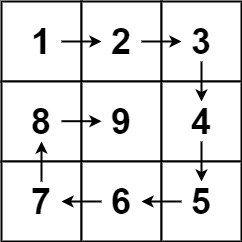
Spiral Matrix II
10 May, 2023
2
2
0
Contributors
Problem Statement:-
Given a positive integer n, generate an n x n matrix filled with elements from 1 to n2 in spiral order.
Link: https://leetcode.com/problems/spiral-matrix-ii/description/
Problem Explanation with examples:-
Example 1

Input: n = 3
Output: [[1,2,3],[8,9,4],[7,6,5]]Example 2
Input: n = 1
Output: [[1]]Constraints
1 <= n <= 20
Intuition:-
- There will be a matrix that will contain the indices of the elements in the spiral order.
- We can use the spiralOrder function from the previous problem to get the indices of the elements in the spiral order.
- We can use the indices from the spiralOrder function to fill the matrix with the numbers from 1 to n*n using a for loop and enumerate function.
Solution:-
- Initialize a variable ans to a matrix of size n*n with all elements as 0.
- Initialize a variable mat to a matrix of size n*n with all elements as tuples of the form (i,j) where i and j are the row and column indices respectively.
- Define a spiralOrder function which takes a matrix as a parameter and returns the elements of the matrix in spiral order as a list by popping the first row and calling the spiralOrder function on the transpose of the matrix.
- Call the spiralOrder function with mat as a parameter and store the result in a variable order.
- For each index ind and value v in order, set the element at the indices v[0] and v[1] in ans to ind+1.
- Return ans.
Code:-
JAVA Solution
class Solution {
public int[][] generateMatrix(int n) {
int[][] ans = new int[n][n];
int[][] mat = new int[n][n];
for (int i = 0; i < n; i++) {
for (int j = 0; j < n; j++) {
mat[i][j] = i * n + j;
}
}
List<Integer> order = spiralOrder(mat);
for (int i = 0; i < order.size(); i++) {
int row = order.get(i) / n;
int col = order.get(i) % n;
ans[row][col] = i + 1;
}
return ans;
}
private List<Integer> spiralOrder(int[][] matrix) {
List<Integer> res = new ArrayList<>();
if (matrix == null || matrix.length == 0) {
return res;
}
int m = matrix.length, n = matrix[0].length;
int[][] dirs = {{0, 1}, {1, 0}, {0, -1}, {-1, 0}};
boolean[][] visited = new boolean[m][n];
int i = 0, j = 0, k = 0;
for (int p = 0; p < m * n; p++) {
res.add(matrix[i][j]);
visited[i][j] = true;
int nexti = i + dirs[k][0], nextj = j + dirs[k][1];
if (nexti < 0 || nexti >= m || nextj < 0 || nextj >= n || visited[nexti][nextj]) {
k = (k + 1) % 4;
nexti = i + dirs[k][0];
nextj = j + dirs[k][1];
}
i = nexti;
j = nextj;
}
return res;
}
}Python Solution
class Solution:
def generateMatrix(self, n: int) -> List[List[int]]:
ans = [[0]*n for k in range(n)]
mat = [[tuple([i, j]) for j in range(n)] for i in range(n)]
def spiralOrder(matrix):
return matrix and list(matrix.pop(0)) + spiralOrder(list(zip(*matrix))[::-1])
order = spiralOrder(mat)
for ind, v in enumerate(order):
ans[v[0]][v[1]] = ind+1
return ansComplexity Analysis:-
TIME:-
The time complexity is O(n^2) because it needs to fill the entire matrix with values from 1 to n^2.
SPACE:-
The space complexity is O(n^2) because it needs to create two matrices, one to store the answer and one to store the coordinates of each cell.
References:-
Connect with me:-
java
python
leetcode
dsa
